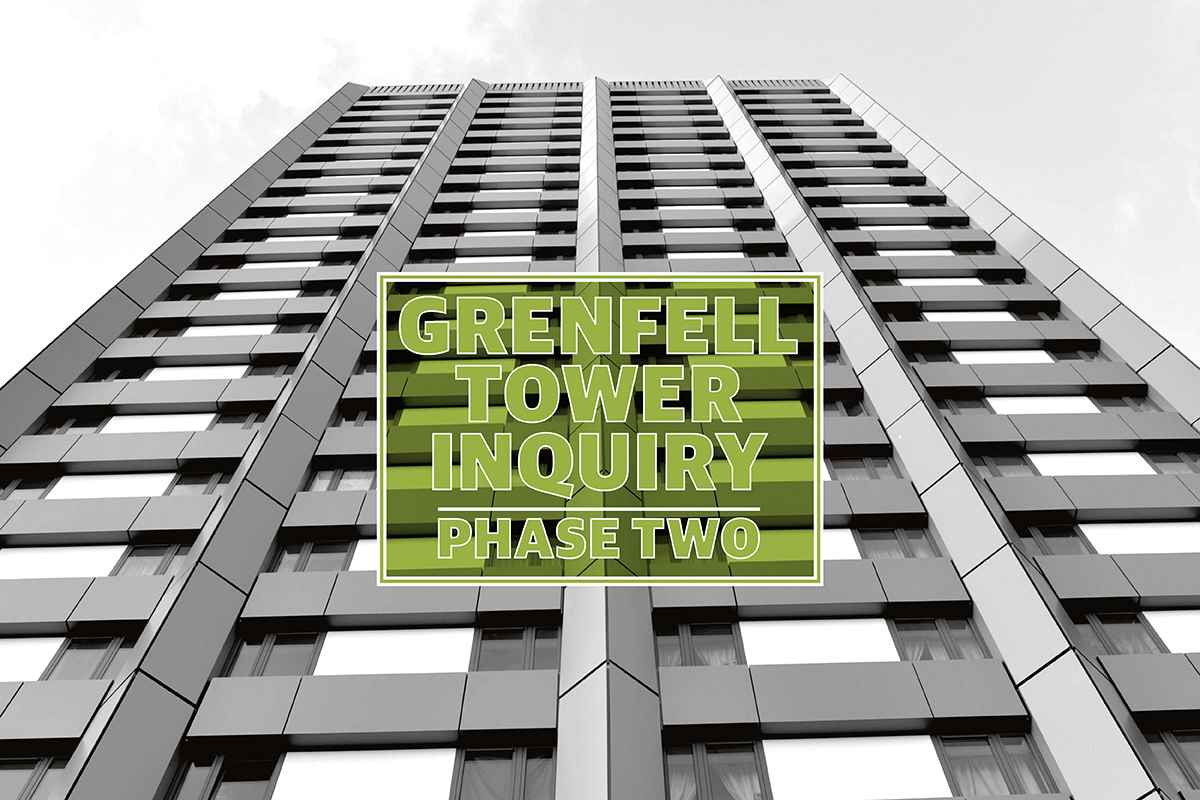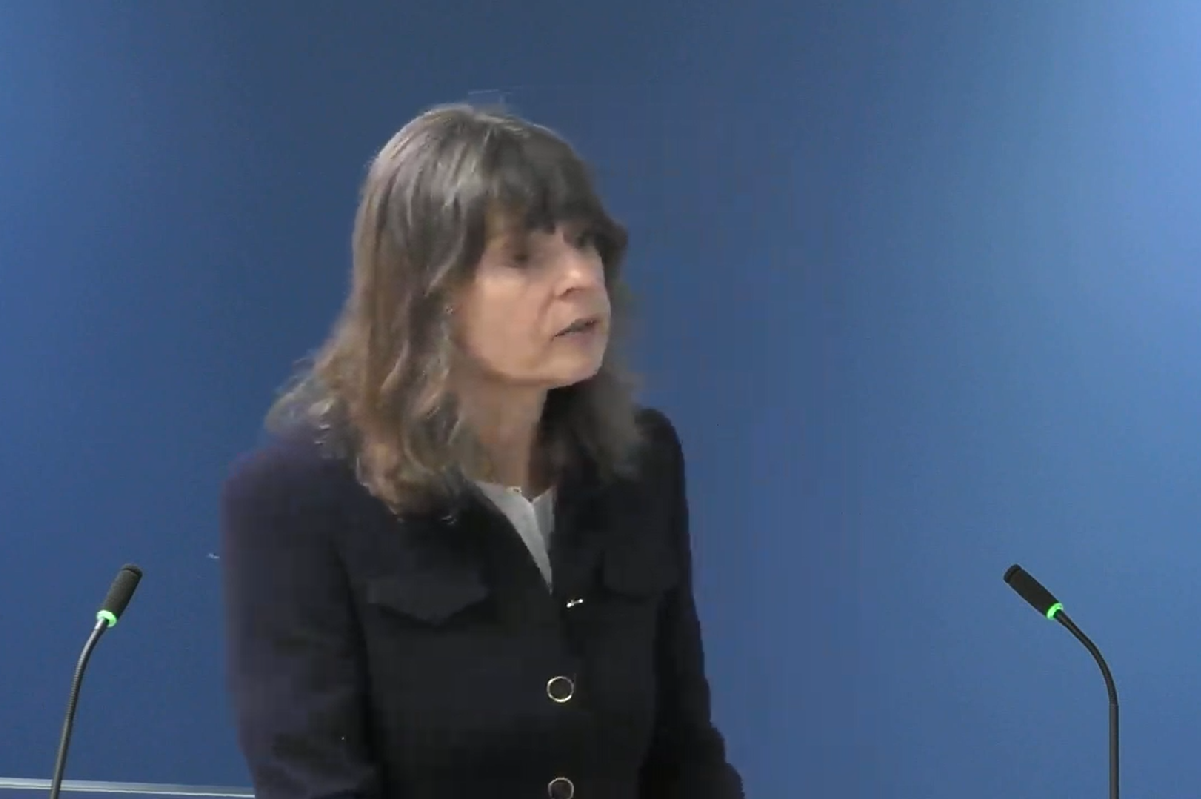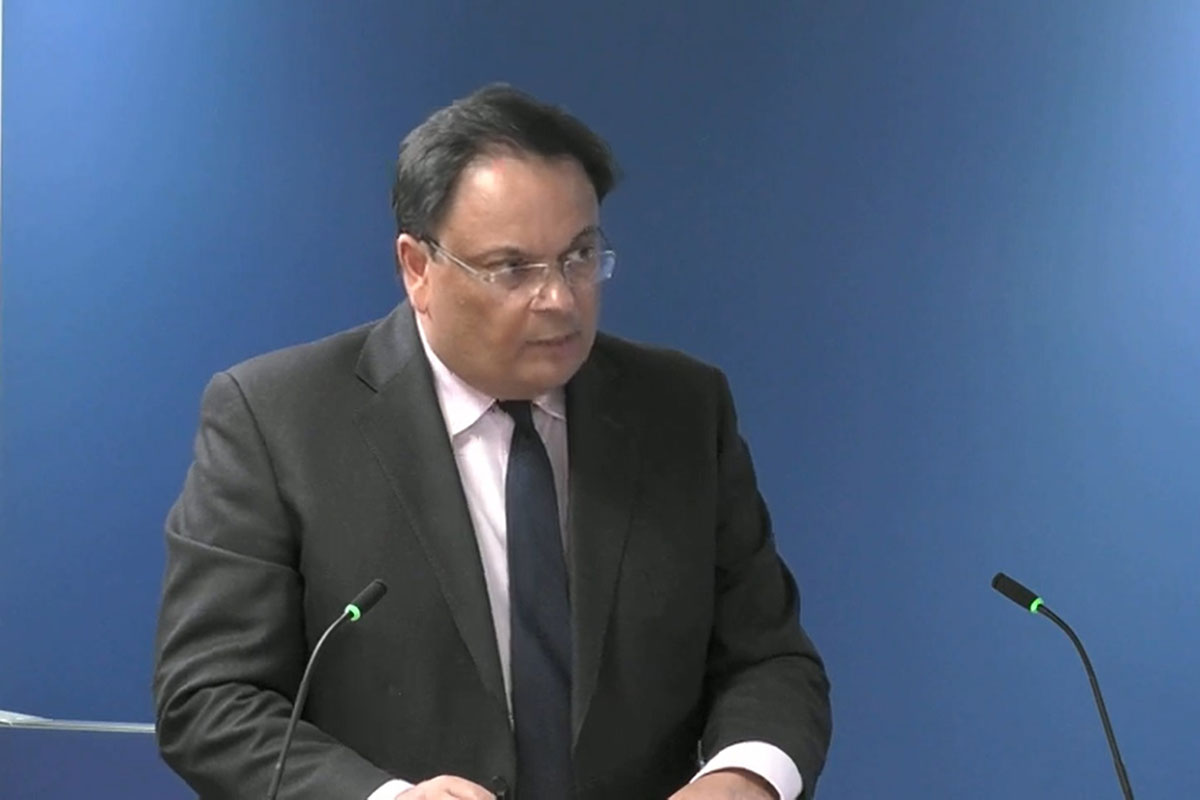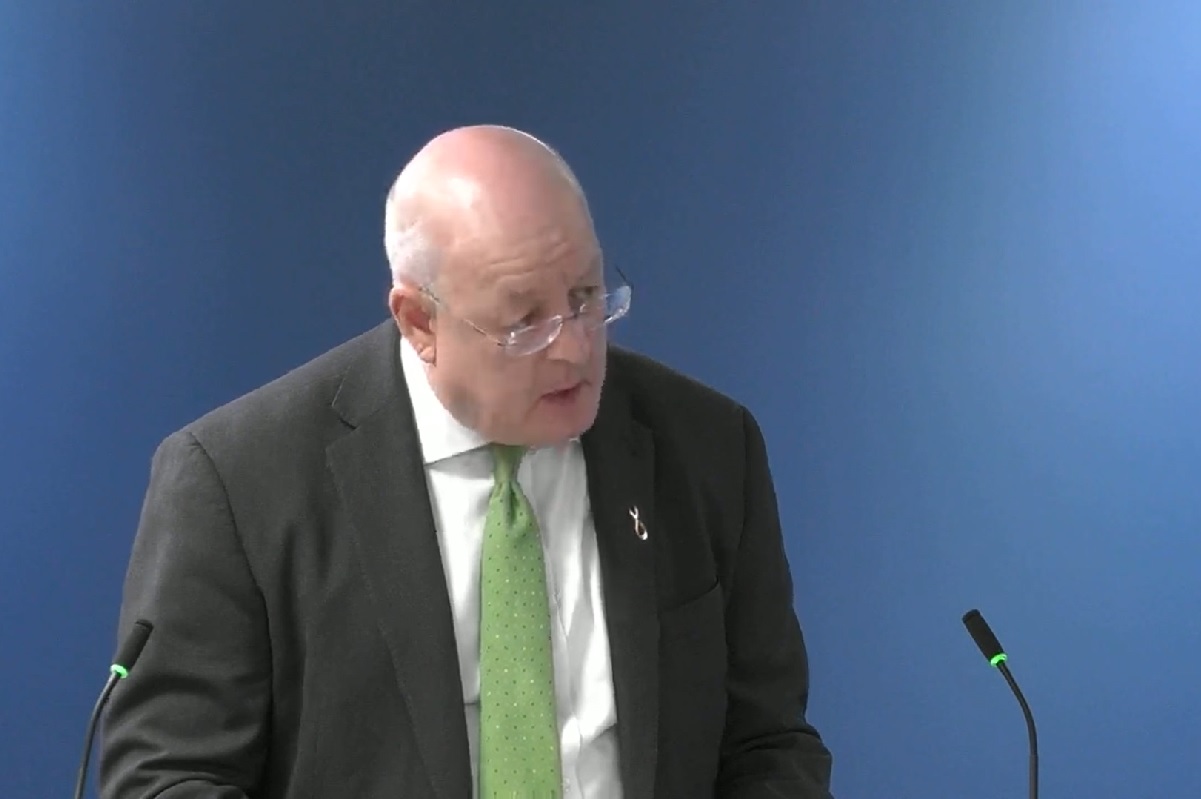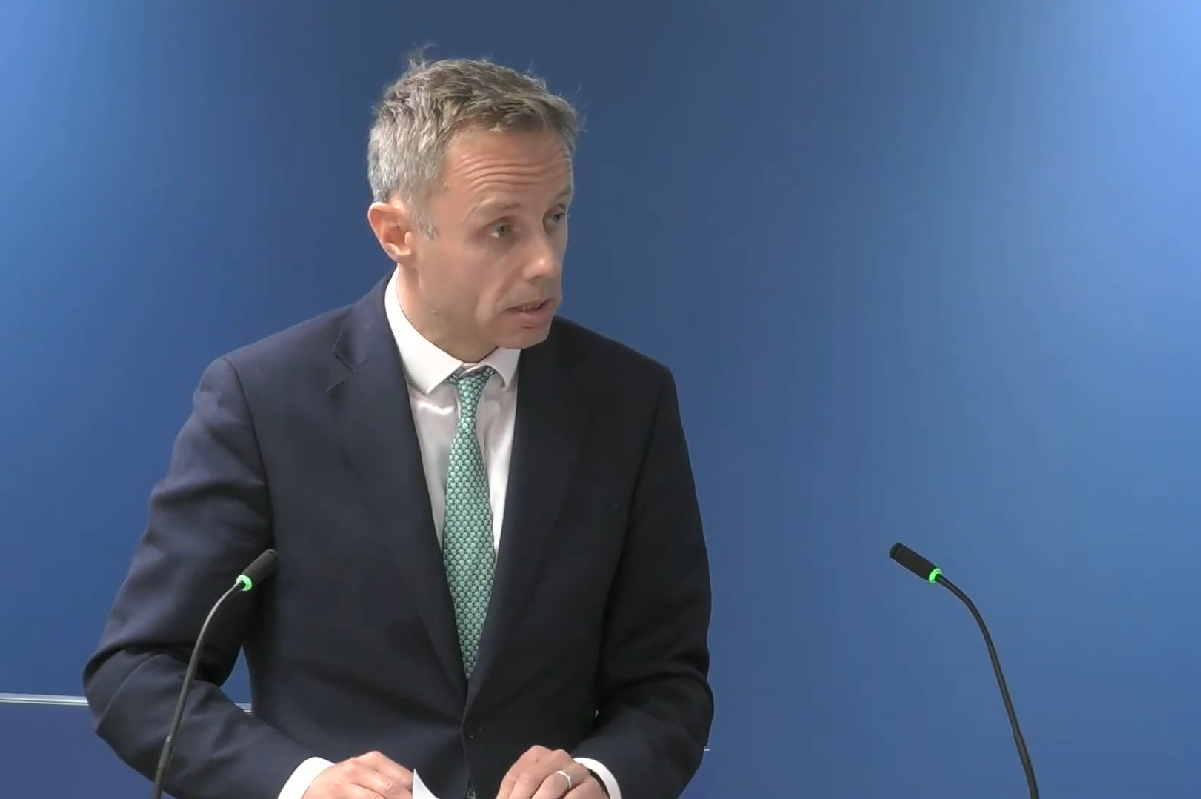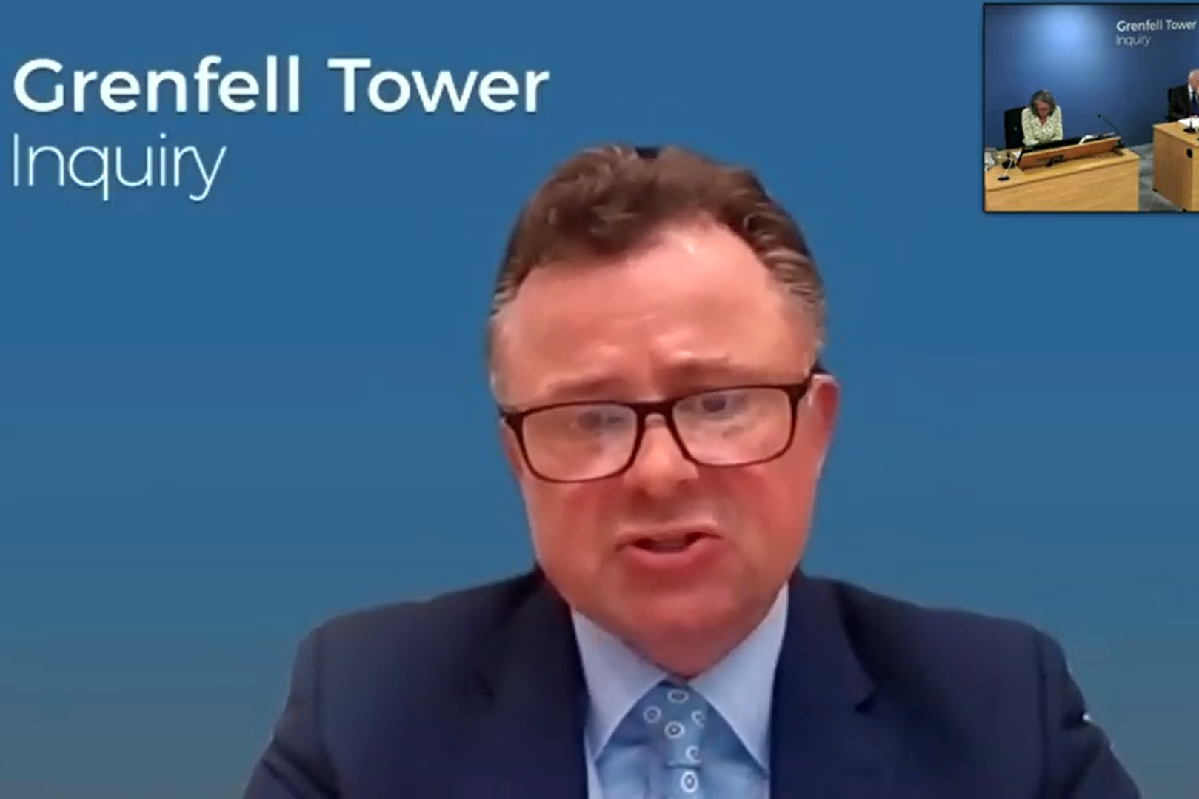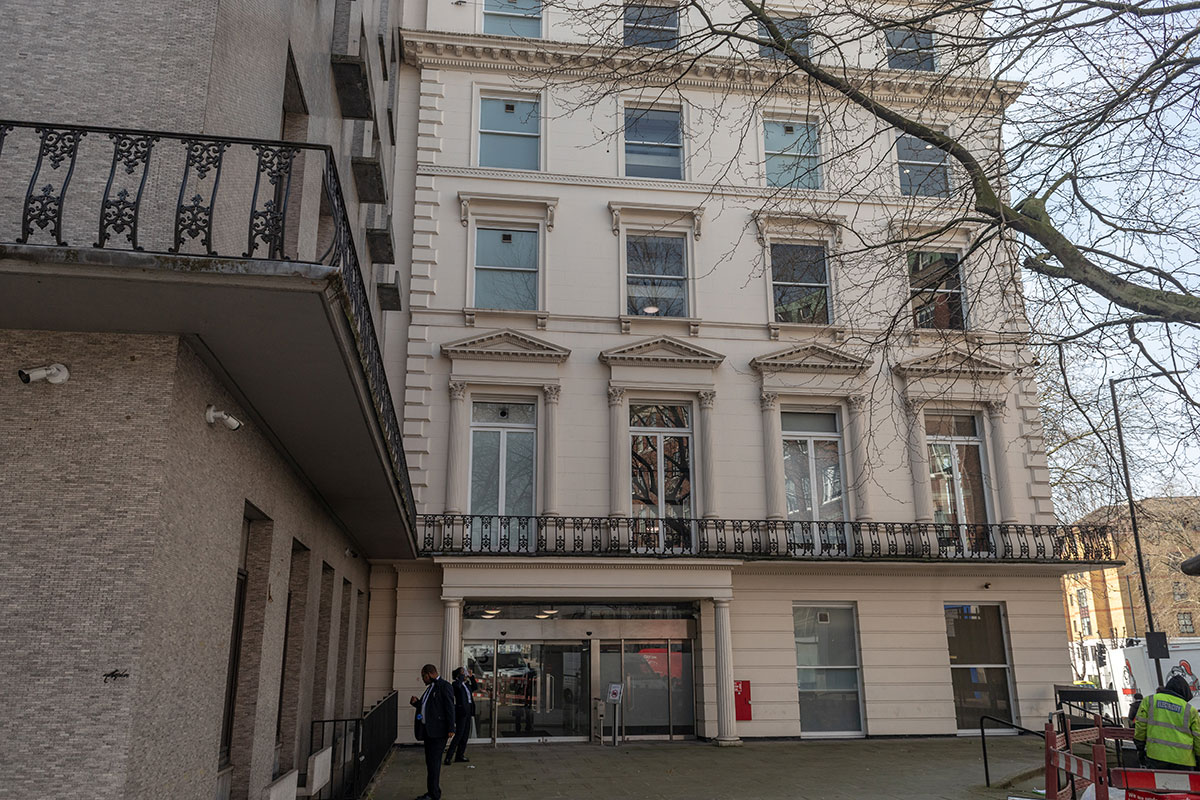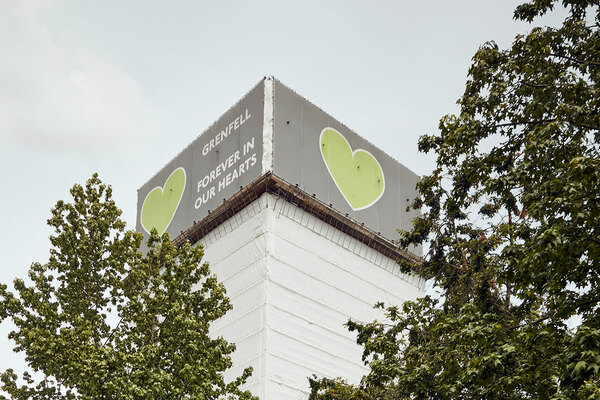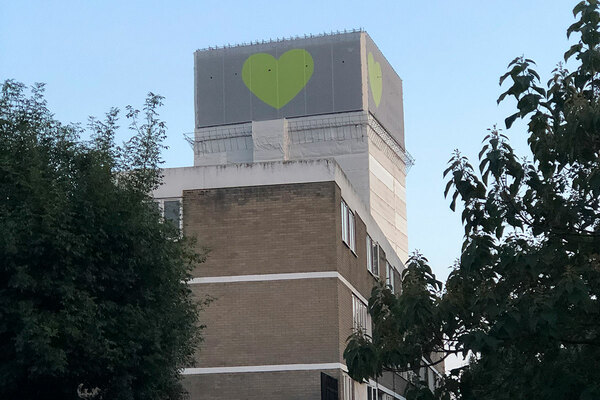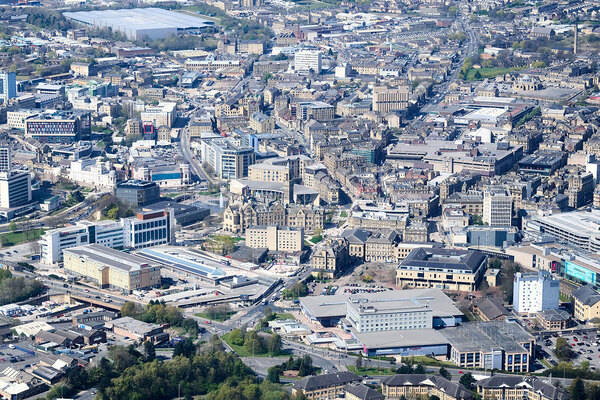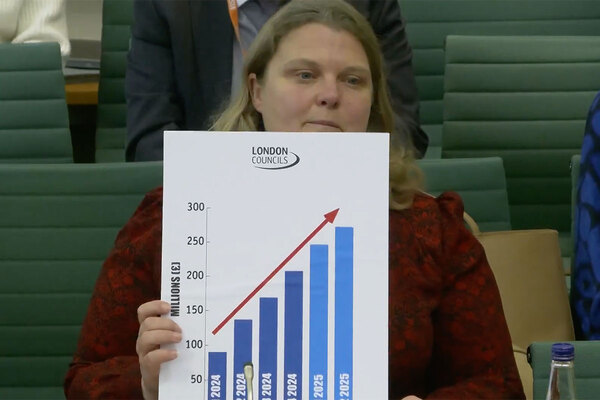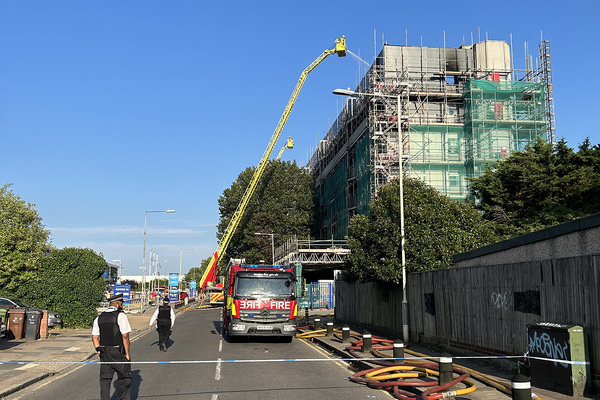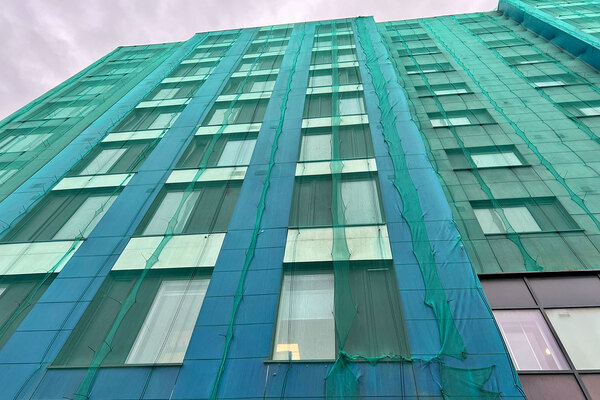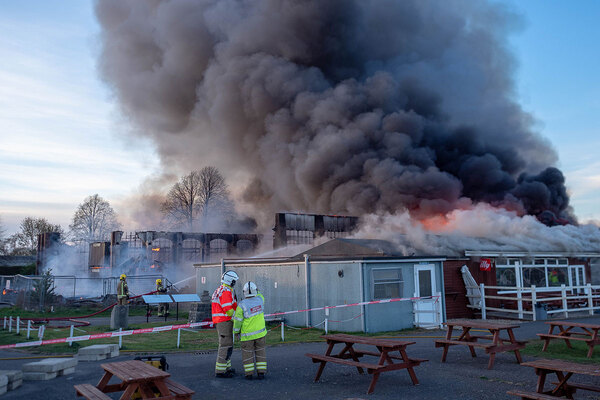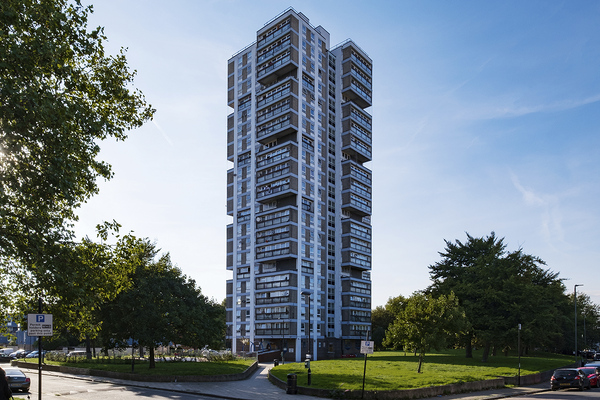Grenfell Tower Inquiry diary week 80: ‘The evidence points to wilful blindness and complacency towards safety’
As the inquiry moves into its final stages, lawyers for the key players gave statements about the evidence surrounding central government. Peter Apps reports
This week, the Grenfell Tower Inquiry heard closing statements from lawyers representing various interested parties which related to the evidence about the actions of central government.
As is now common, the first statements came from those representing the bereaved and survivors, with a number of other parties following over two days, rounded off by the government’s lawyer.
Here is a recap of some of the key themes.
‘Ministers would have the panel believe officials laboured of their own volition under this fatal misapprehension’
At the heart of this module is the evidence surrounding how much the British state knew about the risk of cladding fires before Grenfell and whether it did enough through its regulatory role to minimise the risk of a disaster.
Lawyers for the community were adamant that the answer is not just that the government did not do enough, but that it chose not to, despite knowledge of the risks, because it put more of a priority on deregulation, housebuilding and energy efficiency.
Stephanie Barwise QC (pictured above), appearing for one group of bereaved and survivors, said: “The evidence points to wilful blindness and complacency towards safety, which was subjugated to the more pressing and politically appealing housing and deregulatory agendas.”
She said that the government’s more limited admission that an under-pressure team within an under-resourced department accidentally missed several chances to act was “fundamentally misleading”.
In particular, Ms Barwise called on the panel to reject the evidence of some ministers – notably former communities secretary Eric Pickles – that deregulatory policies were never supposed to apply to building safety regulations.
“Ministers would have the panel believe officials laboured of their own volition under this fatal misapprehension, but that is not credible and the evidence suggests otherwise,” she said.
Ms Barwise also dismissed the idea that a key official – Brian Martin – represented “a single point of failure” in the government. This was how Mr Martin was described by former permanent secretary Melanie Dawes, and a phrase he adopted himself in a statement at the end of his evidence.
“The truth of the matter is that he was put and kept in that position to execute the department’s deregulatory strategy and, indeed, promoted even after Grenfell,” Ms Barwise said, adding that his admitted desire to protect the interests of what he called “UK plc” had “secured his primacy in the building regulations division”.
When Jason Beer QC, representing the Department for Levelling Up, Housing and Communities, appeared on Wednesday, he said there were four factors behind the department’s failure to appreciate the need for change: the lack of a formal oversight role, a reliance on industry, financial constraints and deregulatory policy.
“The department would suggest that these elements combined led to a situation where officials felt unable to escalate concerns when they arose,” he said, agreeing that Mr Martin was not “a single point of failure”.
He said deregulation “played a part in underpinning a culture in the department where officials felt unable properly to escalate warnings when they were raised”, but that the primary problem was “an under-appreciation of the risks”.
Overall, the position Mr Beer set out was similar to his opening statement: that the government’s failure was an oversight and that it failed “to understand how and whether the regulatory system was working in practice or how it was being enforced”. “In this regard, the department failed to exercise sufficient oversight of a system that it owned as the sponsoring government department,” he said.
This framing places the blame more with those in building control roles who, the department said, “were not applying their minds, or not competently applying their minds” to the question of building safety.
Mr Beer was keen to emphasise that the department’s role was “decentralised” and it had no “superintendent” role of building control officers (both in local government and private contractors) who were tasked “to monitor and enforce compliance”.
So the government’s statement effectively admits responsibility for not overseeing the failures of others, while simultaneously emphasising that doing so was not its job.
‘A desire to allow the construction industry sufficient latitude to rapidly build housing’
What then of the specific government failures? You can read some our summaries of the evidence here, here and here.
A key question in this module has been the ‘Class 0’ standard for cladding, which was only removed from official guidance in 2019 (two years after Grenfell) despite clear warnings of its danger stretching back to 1991.
Part of the argument here is that in 2006, the official guidance in Approved Document B was amended to state that ‘filler materials’ were required to meet a higher standard called ‘limited combustibility’.
This has prompted an enormous, five-year long and unresolved argument about what this meant and whether, critically, it covered the combustible core of an aluminium composite material (ACM) panel such as that used on Grenfell Tower.
The ACM used on Grenfell was sold with a certificate saying it was Class 0, meaning that if this was the standard required by government guidance, there is a clear line of responsibility for its use.
What complicates matters is that the guidance is not the only rule builders should have in mind. They also need to consider their statutory responsibility to ensure the walls “adequately resist the spread of flame”.
Mr Beer’s (pictured above) case was that in the event of any ambiguity, builders should have erred on the side of caution and not used ACM.
“The department would reiterate that a competent professional faced with the decision as to whether to use, for example, an ACM PE [polyethylene] panel, should have, in the face of any ambiguity, been referring themselves back to the functional requirement,” he said.
He said the government rejected the suggestion that its public interpretation of the word filler after Grenfell was “an ex post facto rationalisation” or “a political lie” aimed at reducing its responsibility for the fire.
He cited the fact that witnesses from the Building Research Establishment (BRE) had agreed that the measures banned the use of ACM and insisted there had been “no collusion” in their evidence.
Lawyers for the survivors were more damning. Ms Barwise said a culture of dependency on the guidance had grown up in the industry, which resulted in people simply following its provisions.
She said the retention of the Class 0 standard “permits ACM panels, even though that is clearly in conflict with the functional requirement” and that the government had not considered “how the functional requirement was to be achieved effectively” under its guidance.
She said standards were not properly tightened due to “the realisation of a burgeoning cladding crisis” and “a desire to allow the construction industry sufficient latitude to rapidly build housing”.
Mr Beer did accept a failure by the government to respond to the coroner’s recommendations after the Lakanal House fire, saying that deregulatory policies meant “officials felt” unable properly to escalate warnings.
For her part, Ms Barwise said the department “completely ignored all the coroner’s recommendations” following Lakanal and deliberately deferred the review of guidance, despite each minister in role from then until Grenfell being “aware of the dangers” of doing so.
She also said a long delay releasing important reports needed to start the review of Approved Document B “is yet further proof the department was enslaved to its deregulatory agenda in disregard of safety”.
‘The frailty of this house of cards was an ideal prop to facilitate industry capture’
What about the other core participants?
Survivors’ lawyers had some stinging criticism of the BRE, whose witnesses wrote reviews of several key fires, assisted with reviews of Approved Document B and were involved in discussions about the response to a critical warning about the use of ACM in 2014.
You can read some of the evidence from the BRE’s witnesses here and here.
“The role of BRE as advisor on Approved Document B revisions and investigator of fires make it complicit in government’s actions,” said Ms Barwise. “BRE protest that it is not a regulator. We have never said it is, but its code of conduct requires it to hold paramount the health and safety of others. In this fundamental purpose, it failed.”
She described the BRE’s research as “misleading and therefore dangerous” and said its “flaccid” recommendations to the department “were unscientific and did not communicate the sense of urgency or importance”.
Sam Stein QC (pictured above), for another group of survivors, bluntly called for Dr Sarah Colwell, director of fire suppression at the BRE, along with Mr Martin to be sacked.
“Both individuals, through indolence or professional ineptitude, missed clear opportunities to change the system of regulation, which would have prevented the tragedy at Grenfell Tower,” Mr Stein said.
Mr Stein emphasised the BRE’s privatisation in 1997 and the “client relationship” with the government that emerged as a result.
Samantha Leek QC, appearing on behalf of the BRE, insisted that some of this criticism was a result of a misunderstanding of the BRE’s role.
“It is not correct that BRE’s role was to advise government on Approved Document B,” she said. “Each of those misapprehensions suggests that BRE has a role in the regulatory system akin to the department or a government-appointed regulator. It does not.”
She said the BRE’s role was limited to testing and research. “Participants in the inquiry who believe that it was BRE’s role instead of or in parallel with the department to uncover or address those regulatory failures do not understand the role of BRE,” she added.
The community’s lawyers were also critical of the United Kingdom Accreditation Service (UKAS), which was responsible for accrediting the testing work carried out by the BRE.
Ms Barwise said: “UKAS’ failure to witness BRE testing for some seven years between 2008 and 2016 shows a disregard only consistent with not wishing to find problems.
“UKAS emerges as an ineffectual organisation, too willing to assume competence in the bodies it oversaw, and so focused on pleasing them at the expense of public safety that it will not even report fraud.
“The frailty of this house of cards was an ideal prop to facilitate industry capture of an inadequately robust regulatory regime.”
Jonathan Glasson QC, representing UKAS, responded by mostly outlining changes UKAS has made to its processes. He added: “Notwithstanding its acknowledgement that there are lessons to be learned, UKAS does not accept that it is fair to say that the evidence suggests that as an organisation it is not fit for purpose.
“Assessments are necessarily a sampling exercise and it cannot guarantee to find all areas of non-conformity.”
‘Both the LABC and NHBC, private companies, gave false reassurances as to public safety’
There was also criticism for two bodies involved in the process of signing buildings off as compliant: the National House Building Council (NHBC) and Local Authority Building Control (LABC).
We covered the evidence around LABC here, and NHBC here and here.
A major issue with NHBC – which had no involvement in signing off Grenfell Tower – was its general attitude to the use of combustible materials on high-rise buildings.
Despite hearing concerns about the widespread-use of Kingspan K15, and raising several points of concern itself, NHBC never stopped accepting the product for jobs on high rises.
The community’s lawyers said this was because it was concerned about its own position, having already signed off hundreds of blocks with the material and concerned about pushback from its builder clients if it rejected the popular product.
“NHBC’s behaviour demonstrates its total unsuitability as a putative regulator,” said Ms Barwise. “Its acceptance of non-compliant K15 drove it to interpret the regulations and Approved Document B perversely.”
The organisation also controversially published industry guidance in July 2016, which appeared to give approval to the use of ACM and combustible insulation in rainscreen cladding systems.
“[The guidance] permitted the use of the very products used at Grenfell without the need for a test or even a desktop [study],” said Ms Barwise. “While the note itself was not causative of Grenfell, being published after the completion of the refurbishment, it evidences the degree to which industry sought to manipulate and circumvent the regulation.”
LABC meanwhile published certificates for use by their members – building control inspectors at local authorities – which incorrectly implied the both Kingspan and Celotex insulation could legitimately be used on high rises.
Mr Stein described the performance of both organisations as “abject”. “Both the LABC and NHBC, private companies, gave false reassurances as to public safety,” he said.
“The system must be reformed so that the discharge of regulatory functions concerning public safety is put back into the hands of entities that are protected from and not subject to any competing forces such as the desire to make money.
“Further, attention should be paid to the market dominance of organisations such as the NHBC which, because of their market share, hold an inordinate amount of power in shaping safety standards.”
He called for a new “Grenfell standard” in terms of fire safety, which considers what is a basic level of safety, but then adds “a wide margin on top to account for industry crime, builders’ and designers’ ignorance and incompetence and expert error”.
Responses from the NHBC and LABC came on Wednesday. Dominic Adamson QC (pictured above), acting on behalf of LABC, rejected the suggestion that the organisation had acted in any way that could be considered corrupt or dishonest.
He said that the confusion around the meaning of Class 0 and the concept of limited combustibility had nothing to do with LABC.
“The confusion was manipulated by unscrupulous players within the construction industry, such as Kingspan, and the evidence in module six has conclusively demonstrated that successive governments implemented and thereafter maintained a competitive building control regime within a non-prescriptive framework of legislation without sufficient control, oversight,” he said.
He accepted that some of its certificates were “deficient”, but added: “LABC realises that it was manipulated by manufacturers who preyed on industry-wide confusion to obtain LABC certification. It naively believed that applicants acted in good faith.”
Matthew Butt QC, acting on behalf of NHBC, said the organisation refutes any suggestion that it took a lax approach to fire safety.
He described allegations that NHBC’s attempts to address the use of K15 were driven by a desire to hide past errors or were commercially motivated as “an ex post facto rationalisation given to the inquiry”.
Mr Butt said: “The evidence is that between 2013 and 2014, it was primarily NHBC staff challenging Kingspan, requesting test evidence and ultimately driving the industry away from reliance upon certificates, which is now known as an error and based upon deception by manufacturers.”
‘It is now clear beyond any doubt that the nature and speed of the spread of the Grenfell Tower fire was caused by Arconic’s ACM cladding’
Finally, this week the inquiry also heard submissions from product manufacturers Arconic (which made the cladding panels used Grenfell Tower) and Kingspan (which made a small amount of the combustible insulation).
Kingspan’s statement drew attention to the expert evidence of Professor Luke Bisby, who estimated the contribution of the insulation to the fire at between 2% and 10%, with the spread of fire primarily a result of the ACM.
This contribution came from its thermal properties rather than its combustibility, with a system combining ACM with non-combustible insulation resulting in a similarly devastating fire.
“It is now clear beyond any doubt that the nature and speed of the spread of the Grenfell Tower fire was caused by the presence of Arconic’s Reynobond PE-cored ACM cladding,” said Tim Green QC (pictured above), who appeared for Kingspan.
He added: “It is the capacity of insulation to retain heat which is relevant in cladding fires involving PE-cored ACM and not whether that insulation is combustible or non-combustible.”
Professor Bisby did stress that his analysis did not consider the contribution of toxic smoke – an issue that will be considered by another expert, Dr David Purser, next week.
Survivors’ lawyers, however, remained critical of Kingspan’s actions. Ms Barwise said the firm’s behaviour was “seminally causative of the UK market’s willingness to use combustible materials at height” as a result of their “misleading marketing” and efforts to “educate” the market about use of its product.
Mr Green called this claim “without merit”, saying Kingspan had never “promoted the use of combustible materials generally”.
As for Arconic, Stephen Hockman QC argued there were “many other causes at least equal to the ACM panels used in the cladding system on Grenfell”, including the failure to introduce suitable barriers around the windows.
He added: “What happened at Grenfell was truly a storm in which the ACM panels were but one component of the maelstrom.”
He said there was “ample evidence that ACM was in regular use for many years before the fire” in the UK and that this was “facilitated by the then-applicable regulatory regime”.
Regarding the regulations, Mr Hockman said: “It seems to us very clear that there was, in fact, simply no requirement in relation to the rainscreen to be of limited combustibility and, indeed, the approach of your own counsel has been that the regime permitted the choice of a material by reference to its surface alone, rather than its core.”
“If this was an approach which could have been taken in good faith by a UK supplier, then that must have been all the more true in the case of a non-UK supplier,” he said.
The inquiry continues.
Grenfell Tower Inquiry week 80: headlines
The government has admitted that it failed to put in place or provide sufficient oversight of a regulatory system that could have prevented the Grenfell Tower fire.
The government’s rejection of the Grenfell Tower Inquiry’s recommendation that plans should be made for the evacuation of disabled people in high rises “strikes at the heart” of the inquiry’s purpose, lawyers for the community have said.
The government was “enslaved to a deregulatory agenda” and adopted “wilful blindness and complacency towards safety” resulting in more than 13 missed opportunities to tighten a critical fire safety standard in the years before the Grenfell Tower fire, lawyers for bereaved and survivors have said.
Sign up for our weekly Grenfell Inquiry newsletter
Each week we send out a newsletter rounding up the key news from the Grenfell Inquiry, along with the headlines from the week
Already have an account? Click here to manage your newsletters
Grenfell Tower Inquiry phase two: weekly diaries
Module one: the refurbishment
Week one: A vivid picture of a broken industry
After a week of damning revelations at the opening of phase two of the Grenfell Tower Inquiry, Peter Apps recaps the key points
Click here to read the full story
Week two: What is the significance of the immunity application?
Sir Martin Moore-Bick has written to the attorney general requesting protection for those set to give evidence at the Grenfell Tower Inquiry. Peter Apps explains what the move means
Click here to read the full story
Week three: Architects of misfortune
This week saw the lead architects for the Grenfell Tower refurbishment give evidence to the inquiry. Peter Apps runs through the key points
Click here to read the full story
Week four: ‘I didn’t have any perception that it was the monster it’s become’
The architects continued to give evidence this week, outlining a lack of understanding of the fire risk posed by the cladding materials and its design. Nathaniel Barker reports
Click here to read the full story
Week five: ‘No adverse effect in relation to external fire spread’
As the Grenfell Tower Inquiry returns from its long absence, Peter Apps recaps the key points from a week of important evidence from the fire consultants to the refurbishment
Click here to read the full story
Week six: ‘I can’t recall any instance where I discussed the materials with building control’
Nathaniel Barker summarises what we learned from fire engineers Exova, architects Studio E and the early evidence from contractor Rydon
Click here to read the full story
Week seven: ‘I do not think I have ever worked with a contractor operating with this level of nonchalance’
Two key witnesses from contractor Rydon gave evidence this week. Peter Apps recaps some of the key points from a revealing week of evidence
Click here to read the full story
Week eight: ‘It haunts me that it wasn't challenged’
Four witnesses from contractor Rydon gave evidence this week. Lucie Heath recaps what we learned on the last week of evidence before the inquiry breaks for five weeks
Click here to read the full story
Week nine: ‘All I can say is you will be taken out for a very nice meal very soon’
This week the inquiry heard evidence from witnesses at Harley Facades, the sub-contractor responsible for Grenfell Tower’s cladding. Peter Apps recaps the key points
Click here to read the full story
Week 10: ‘As we all know, ACM will be gone rather quickly in a fire!’
As the Grenfell Tower Inquiry entered its 10th week, Jack Simpson recaps the key points from a week of important evidence from the refurbishment’s cladding contractor
Click here to read the full story
Week 11: ‘Did you get the impression Grenfell Tower was a guinea pig for this insulation?’
With witnesses from the cladding subcontractor, the firm which cut the deadly panels to shape and the clerk of works which inspected the job giving evidence this was week full of revelations. Peter Apps recaps the key points
Click here to read the full story
Week 12: ‘Would you accept that was a serious failing on your part?’
With the surveyor who inspected Grenfell Tower for compliance giving evidence, this was a crucial week from the inquiry. Dominic Brady and Peter Apps report
Click here to read the full story
Week 13: ‘Value for money is to be regarded as the key driver for this project’
With consultants to Kensington & Chelsea Tenant Management Organisation (KCTMO) giving evidence, attention at the Grenfell Tower Inquiry turned for this first time to the actions of the TMO and the council. Peter Apps reports
Click here to read the full story
Week 14: ‘Did it not occur to you at this point that your budget was simply too low?’
This week, for the first time in phase two, the inquiry heard from Kensington & Chelsea Tenant Management Organisation, the landlord that oversaw the fatal refurbishment of Grenfell Tower. Lucie Heath reports
Click here to read the full story
Week 15: ‘Have you ever informed the police that you destroyed documents relevant to their investigation?’
Witnesses from the Kensington and Chelsea Tenant Management Organisation (KCTMO) gave evidence for a second week, which began with a shocking revelation about withheld and destroyed evidence. Peter Apps recaps
Click here to read the full story
Week 16: ‘I conclude this was very serious evidence of professional negligence’
This week saw members of Kensington & Chelsea Tenant Management Organisation finish giving evidence, before the inquiry’s expert witnesses took the stand to make some highly critical assessments of the work they had seen before and during the refurbishment of Grenfell Tower. Jack Simpson recaps
Click here to read the full story
Grenfell Tower: a timeline of the refurbishment
Following the conclusion of module one of the Grenfell Inquiry’s second phase, Peter Apps presents a timeline of the key moments during the fatal refurbishment of the west London tower block
Click here to read the full story
Module two: the cladding products
Week 17: ‘It’s hard to make a note about this because we are not clean’
The start of the second module of the Grenfell Tower Inquiry phase two came with some huge revelations about the companies that sold the products used in the cladding system. Peter Apps reports
Click here to read the full story
Week 18: ‘It was just reckless optimism wasn't it?’
As the inquiry began cross-examining witnesses for the second module of its phase two work, the picture surrounding just how Grenfell Tower ended up wrapped in such dangerous materials became a little clearer. Nathaniel Barker was keeping an eye on proceedings
Click here to read the full story
Week 19: ‘And that was intentional, deliberate, dishonest?’
The Grenfell Tower Inquiry this week heard the shocking story of how the insulation manufacturer “manipulated” official testing and marketed its product “dishonestly”. Peter Apps tells the story
Click here to read the full story
Week 20: ‘We were outed by a consultant who we then had to fabricate a story to’
This week the inquiry investigated the actions of Kingspan – the manufacturer of one of the insulation products used in the tower’s cladding system. Dominic Brady reports
Click here to read the full story
Week 21: ‘It’s there in black and white isn't it? We see a complete absence of any consideration of life safety’
The story of insulation giant Kingspan’s testing and marketing of its combustible insulation for high rises was unpacked in minute detail this week. Peter Apps reports
Click here to read the full story
Week 22: ‘All we do is lie in here’
In the third week of evidence from insulation giant Kingspan, the inquiry continued to uncover shocking details about the firm’s behaviour both before and after the Grenfell Tower fire. Lucie Heath reports
Click here to read the full story
Week 23: ‘That would have come as an earthquake to you at the time, would it not?’
This week the inquiry took its deepest dive yet into the inner workings of the cladding manufacturer whose product has been blamed for the terrible spread of fire up Grenfell Tower. Nathaniel Barker reports
Click here to read the full story
Week 24: ‘Do you accept that Test 5B was Arconic's deadly secret’
The president of the firm that made and sold the cladding panels installed on Grenfell Tower was asked to account for the apparent concealment of “disastrous” fire tests on the product this week. Peter Apps reports
Click here to read the full story
Week 25: ‘This is quite an incredible list of omissions and missed instances, isn’t it?’
This week the Grenfell Tower Inquiry heard its first witnesses from the Building Research Establishment (BRE) - the testing house which carried out key fire tests on the Kingspan and Celotex insulation products which were later used on Grenfell Tower. Peter Apps reports.
Click here to read the full story
Week 26: 'You were taking an enormous risk, weren't you?'
Week 26 at the Grenfell Tower Inquiry was a key moment in understanding how dangerous products used on the tower came to be accepted by industry professionals. Dominic Brady reports
Click here to read the full story
Week 27: ‘What will happen if one building made out [of] PE core is in fire and will kill 60 to 70 persons?’
The most explosive evidence this week at the Grenfell Tower Inquiry came from those who did not attend, as the evidence which would have been presented to Arconic witnesses was displayed in their absence. Peter Apps reports
Click here to read the full story
Week 28: ‘This is a serious safety matter’
This week the Grenfell Tower Inquiry zeroed in on the British Board of Agrément, the body that produced “misleading” certificates which inspired trust in both the cladding and insulation used on the tower. Lucie Heath reports
Click here to read the full story
Week 29: ‘Is it true that Kingspan’s position… was to do its best to ensure that science was secretly perverted for financial gain?’
The final week in this section of the Grenfell Tower Inquiry primarily examined the attempts by insulation manufacturer Kingspan to lobby government after the fire. Peter Apps reports
Click here to read the full story
How the products used in Grenfell Tower's cladding system were tested and sold
As the section of the Grenfell Tower Inquiry examining how the products used in the cladding system were tested, marketed and sold comes to a close, Peter Apps summarises what we have learned about each of the products included in the system
Click here to read the full story
Module Three: the management of the tower
Week 30: ‘There is certainly a high probability that in the event of a fire the whole building can become an inferno’
The focus of the inquiry shifted this week to the actions of the social housing providers responsible for maintaining Grenfell Tower. Pete Apps recaps what we learned
Click here to read the full story
Week 31: ‘If we cannot get out people will die’
This week saw the former residents of Grenfell Tower enter the witness box to tell of their experiences attempting to raise complaints with the council and its managing agent. Pete Apps reports
Click here to read the full story
Week 32: ‘Let's hope our luck holds and there isn't a fire’
This week saw the return of the landlord of Grenfell Tower, Kensington and Chelsea Tenant Management Organisation (KCTMO), as senior staff members attempted to explain how vital fire safety protections at the block were allowed to fall into disrepair. Lucie Heath reports
Click here to read the full story
Week 33: ‘Isn't that a serious gap in the scope of a policy meant to safeguard vulnerable people?’
A slightly disjointed week at the Grenfell Tower inquiry saw further evidence from staff at building manager Kensington and Chelsea Tenant Management Organisation (KCTMO) interspersed with the views of a cladding expert. Peter Apps reports
Click here to read the full story
Week 34: ‘Some members of the community are doing their best to spread false information’
Jack Simpson covers all the major revelations from the past week of evidence at the Grenfell Inquiry, including evidence from Laura Johnson, director of housing at the Royal Borough of Kensington and Chelsea.
Click here to read the full story
Week 35: ‘I really didn’t like the champagne’
This week the Grenfell Tower Inquiry saw council witnesses, including former deputy leader Rock Feilding-Mellen and leader Nicholas Paget-Brown, questioned about their role in the story for the first time. Peter Apps reports
Click here to read the full story
Week 36: ‘Is that not a very incurious approach for a fire risk assessor?’
This week the Grenfell Tower Inquiry scrutinised the work of Carl Stokes, the man hired to carry out fire risk assessments for the block. Nathaniel Barker reports
Click here to read the full story
Week 37: ‘In giving that advice, weren’t you acting beyond your knowledge and expertise?’
A curtailed week at the Grenfell Tower Inquiry saw fire risk assessor Carl Stokes grilled over advice he gave regarding the tower’s cladding. Peter Apps reports
Click here to read the full story
Week 38: ‘Well it’s a bit more than that, isn’t it. He’s suggesting that you tell the LFB a lie’
The inquiry heard the mammoth cross-examination of KCTMO’s health and safety manager Janice Wray this week. Peter Apps reports
Click here to read the full story
Week 39: ‘What you said there was a grotesque understatement’
This week the inquiry continued to hear from former employees of Kensington and Chelsea Tenant Management Organisation, as well as two employees from the London Fire Brigade. Lucie Heath reports
Click here to read the full story
Week 40: ‘An exercise in concealment and half-truth’
Former KCTMO chief executive Robert Black gave his evidence to the inquiry this week and was asked to account for the various failures described over the previous six weeks. Peter Apps and Nathaniel Barker report.
Click here to read the full story
Week 41: ‘We should do nothing. This is not the sort of website we should be responding to’
This week saw the return of Robert Black, chief executive of Kensington and Chelsea Tenant Management Organisation (KCTMO), before the inquiry turned its attention to the defective smoke control system in the tower. Dominic Brady reports
Click here to read the full story
Week 42:‘They would leak as much as they leaked. They were what they were’
The Grenfell Tower Inquiry continued its in-depth investigation of the tower’s non-compliant smoke control system this week, with evidence from the various contractors involved in delivering it. Pete Apps reports
Click here to read the full story
Week 43:‘Contractors at the time were not generally aware of the importance of leaving holes unsealed’
This week the inquiry focused on two of the more overlooked areas of the Grenfell Tower fire, with evidence focusing on the gas pipelines and lifts within the west London block. It was a packed week, with five witnesses giving evidence. Jack Simpson reports
Click here to read the full story
Week 44:‘I've never seen a fully compliant firefighting lift in any local authority building, to this day actually’
This week the inquiry turn the focus onto the building’s defective lifts, with evidence from an expert, contractors who worked on them and a former engineer at KCTMO. Pete Apps reports.
Click here to read the full story
Week 45: ‘Don’t you find all this rather a surprising debate, given that the Equality Act was passed in 2010?’
The inquiry heard from expert witness Colin Todd this week, who gave his views about the work of risk assessor Carl Stokes as well as answered questions about his own guidance. Peter Apps and Nathaniel Barker report
Click here to read the full story
Week 46: ‘I think I've been very, very clear that is completely wrong’
This week the inquiry heard further expert evidence about fire risk assessor Carl Stokes’ actions, as the section of its work covering the management and maintenance of the tower concluded. Peter Apps reports
Click here to read the full story
Six key failures in the way Grenfell Tower was managed before the fire
Peter Apps recaps some of what we have learned about the actions of the Royal Borough of Kensington and Chelsea (RBKC) and Kensington and Chelsea Tenant Management Organisation (KCTMO) in the years before the fire.
Module one and two closing statements
Week 47: ‘An unedifying spectacle’
After a week of closing statements from the core participants involved in modules one and two, Lucie Heath recaps the key arguments of each group
Click here to read the full story
Module five: the fire brigade
Week 48: ‘They knew, and lives could and should have been saved’
The phase of the Grenfell Tower Inquiry examining the actions of the London Fire Brigade in the years before the fire kicked off this week with some major revelations. Peter Apps reports
Click here to read the full story
Week 49: ‘I'm not sure we've always taken every opportunity to learn as an organisation’
How the London Fire Brigade acted upon lessons from incidents in the years before the Grenfell Tower disaster came under the microscope this week at the public inquiry. Nathaniel Barker reports
Click here to read the full story
Week 50: ‘There is a culture in LFB that is very conservative. I think there is great comfort in what is familiar’
This week the inquiry heard how the London Fire Brigade (LFB) elected not to issue warnings about dangerous cladding before Grenfell and a detailed examination of its policy for checking high risk buildings. Pete Apps reports.
Click here to read the full story
Week 51:‘We teach firefighters to expect building failure’
An unusually brief week of evidence at the Grenfell Tower Inquiry explored how a fire service neighbouring London was taking a different approach to tackling blazes in high rises. Nathaniel Barker reports
Click here to read the full story
Week 52: ‘I actually think that there is a measure of incompetence at all levels’
Expert evidence concluded the current section of the inquiry with some stinging criticism of the London Fire Brigade (LFB). Pete Apps and Grainne Cuffe report.
Click here to read the full story
Module six: fire services
Week 53: ‘They make for chilling reading and harrowing listening’
The inquiry’s investigation into central government began this week with lawyers setting out their view on how and why firefighting policies failed. Peter Apps and Lucie Heath report
Click here to read the full story
Week 54: ‘Our consideration of evacuation at this time was something of a blind spot’
The development of policy on ‘stay put’, both nationally and for London, occupied the attention of the inquiry this week. Peter Apps reports
Click here to read the full story
Week 55: ‘My review is pretty scathing!’
In a week that included the 200th day of evidence in phase two of the inquiry, attention turned to the London Fire Brigade’s control room. Lucie Heath reports
Click here to read the full story
Week 56: ‘Why didn't we thump the table harder’
This week, the control room at the London Fire Brigade was examined further – both before and after the fire. Pete Apps and Lucie Heath report
Click here to read the full story
Week 57: ‘It was worse than slow, it was sluggish’
Former London Fire Brigade (LFB) commissioner Dany Cotton was the star witness this week, as the inquiry continued to delve into the brigade’s knowledge and training before the Grenfell Tower fire. Jack Simpson, Grainne Cuffe and Pete Apps report
Click here to read the full story
Week 58: ‘I don't think we deserve to ask for trust until we demonstrate different outcomes’
A current and former commissioner of the London Fire Brigade (LFB) wrapped up the inquiry’s investigation into the actions of the brigade before the fire. Grainne Cuffe and Peter Apps report.
Module six: testing and government
One of the major scandals of our time: key revelations as the Grenfell Tower Inquiry turns to government
The government was accused of “covering up” the risks of dangerous cladding as its “unbridled passion for deregulation” left it a “junior party” to the construction industry as the latest phase of the public inquiry opened today. Peter Apps summarises some of the main points
Click here to read the full story
Week 59: ‘Recent tests have apparently shown it continued to burn for 20 minutes after the flame was taken away’
After shocking opening statements, the Grenfell Tower Inquiry turned its attention to the work of Local Authority Building Control. Pete Apps reports
Click here to read the full story
Week 60: ‘You could have an exact repeat of the Dubai fire in any number of buildings in London’
The Grenfell Tower Inquiry turned its attention to the work of the National House Building Council this week, with shocking revelations about the extent of the warnings issued to central government before the fire. Peter Apps reports
Click here to read the full story
Week 61: ‘Mistakes are meant for learning, not repeating’
In the first hearings of the new year, the Grenfell Tower Inquiry heard closing statements from the firefighting section of phase two. Lucie Heath reports
Click here to read the full story
Week 62: Did it ever occur to you that this act of collaboration was, in one sense, corrupting?
The Grenfell Tower Inquiry returned to the work of the National House Building Council (NHBC) this week, with a new shocking revelation about the government’s actions in the immediate aftermath of the fire. Peter Apps reports
Click here to read the full story
Week 63: ‘It came after the general move to deregulation. So more regulation was not welcome’
The government’s focus on deregulation before the Grenfell Tower fire was placed in the spotlight this week with a series of shocking revelations about its failure to amend fire safety guidance. Pete Apps and Grainne Cuffe report
Click here to read the full story
Week 64: ‘I didn’t think ACM would be suitable for use in any high-rise buildings. I don’t think anyone did’
This week, the Building Research Establishment’s Dr Sarah Colwell gave more than three days of evidence, with some huge revelations about what was known about the dangers of aluminium composite material years before the fire and the mass confusion over the government’s building regulations. Peter Apps and Jack Simpson report
Click here to read the full story
Week 65: ‘Unless the government does something now about ACM panels, people will die’
Further evidence from the Building Research Establishment and the first government witnesses added new depth to our understanding of how warnings were missed before the Grenfell Tower fire. Peter Apps reports
Click here to read the full story
Week 66: ‘Was there a cover-up?’
The latest evidence from the Grenfell Tower Inquiry tracked the government’s failure to act on fire safety warnings right up until the months before the fire. Peter Apps and Grainne Cuffe report
Click here to read the full story
Week 67: ‘When exposed to a fire, the aluminium melts away and exposes the polyethylene. Whoosh!’
This week the inquiry heard disturbing new evidence about the failure of senior government officials to act on warnings about dangerous cladding in the years before the Grenfell Tower fire. Peter Apps reports
Click here to read the full story
Week 68: ‘Can we agree that was a pretty dangerous thing to have, all this falling on one man’s shoulders?’
Three senior civil servants gave evidence this week, including the official who had responsibility for building regulations guidance on fire safety in the years before Grenfell. Peter Apps, Lucie Heath, Stephen Delahunty and Grainne Cuffe report
Click here to read the full story
Week 69: ‘It was just unthinkable. You had the makings here of a crisis you could not comprehend’
This week, civil servant Brian Martin gave his long-awaited evidence to the Grenfell Tower Inquiry. Peter Apps reports
Click here to read the full story
Week 70: ‘Show me the bodies’
An important week at the Grenfell Tower Inquiry saw a dramatic conclusion to the mammoth cross-examination of civil servant Brian Martin, as well as the first politicians. Peter Apps and Lucie Heath report
Click here to read the full story
Week 71: ‘I have changed my schedule to fit this in. I do have an extremely busy day meeting people’
Three politicians who were responsible for building regulations before Grenfell appeared before the inquiry this week, including the former communities secretary Eric Pickles, who responded to the coroner’s letter following the Lakanal House fire. Peter Apps and Lucie Heath report
Click here to read the full story
Module Four: aftermath
Week 72: 'The system isn't broken. It was built this way'
This week the inquiry turned to the shocking story of the lack of support for bereaved and survivors in the immediate aftermath of the Grenfell Tower fire. Peter Apps, Lucie Heath, Grainne Cuffe and Jack Simpson report
Click here to read the full story
Week 73: ‘Most people would regard that as hopeless’
This week, the Grenfell Tower Inquiry heard about the Royal Borough of Kensington and Chelsea’s chaotic response in the immediate aftermath of the blaze, from the staff responsible for it. Pete Apps, Stephen Delahunty and Grainne Cuffe report
Click here to read the full story
Week 74: ‘Do you agree that RBKC was ill-prepared and incapable to meet its duties’
This week, Nicholas Holgate, former chief executive of the Royal Borough of Kensington and Chelsea, was grilled on his failure to hand over control of the aftermath of the fire, despite the borough’s lack of capacity. Peter Apps reports
Click here to read the full story
Week 75: ‘It still shocks me to the core that that’s how we treat our citizens in this country’
This week the inquiry heard witnesses from the housing management body discuss their role in the aftermath of the Grenfell Tower fire, followed by a range of witnesses from other organisations which supported the response. Peter Apps and Grainne Cuffe report
Click here to read the full story
Week 76: ‘I fear this will become our New Orleans’
This week the inquiry heard from central government figures and members of the London-wide emergency response arrangements. Peter Apps and Grainne Cuffe report
Click here to read the full story
Week 77: ‘The planning wasn’t done and there was nothing for us to be drawing on’
The Grenfell Tower Inquiry’s examination of the aftermath of the fire concluded with witnesses from central government. Peter Apps reports
Click here to read the full story
Module seven: expert evidence and closing statements
Week 78: ‘The abandonment of the ‘stay put’ strategy for high-rise residential buildings is essential’
This week the Grenfell Tower Inquiry heard a range of expert witnesses discuss their reports. Peter Apps and Grainne Cuffe report
Click here to read the full story
Week 79: ‘You could argue the system was created to enable people to circumvent the rules’
The Grenfell Tower Inquiry continued to hear expert evidence this week, with two senior figures in the world of fire safety academia criticising the government’s approach before and after the blaze. Peter Apps and Grainne Cuffe report
Click here to read the full story
Week 80: ‘The evidence points to wilful blindness and complacency towards safety’
As the inquiry moves into its final stages, lawyers for the key players gave statements about the evidence surrounding central government. Peter Apps reports
Click here to read the full story
Week 81: ‘This is Islamophobia. It’s racism. It is the elephant staring back at us in the room’
This week, closing statements covering the aftermath of the fire delivered a shocking new revelation and an expert toxicologist gave his views on the causes of the deaths. Peter Apps reports
Click here to read the full story
Module eight: further evidence relating to the deceased
Week 82: ‘Their chance to hear about the circumstances in which their loved ones died is the culmination of five years of waiting’
The Grenfell Tower Inquiry moved into its final module this week, with evidence relating to the circumstances in which the victims died. Peter Apps reports
Click here to read the full story
Week 83: ‘They died together as they lived: caring for one another’
A second week of evidence relating to the circumstances in which the victims of the fire died delivered more heartbreaking stories about their final moments. Peter Apps recaps
Click here to read the full story
Week 84: ‘Every decision affects someone who is an adored child, a beloved sister, a respected uncle, a needed mother’
The final week of oral evidence for the Grenfell Tower Inquiry’s second phase contained more heartbreaking evidence about the deaths in the tower. Peter Apps reports
Click here to read the full story
Closing statements
Week 85: ‘The merry-go-round turns still, the notes of its melody clearly audible in the last few days’
The Grenfell Tower Inquiry returned this week for closing statements from lawyers representing the bereaved and survivors and the various parties under scrutiny for the fire. Pete Apps reports.
